Abstract
The main objective of this research work was the wellbore stability evaluation of oil and gas wells based on a 3D geomechanical model, which as constructed using seismic inversion in a southeastern Algerian petroleum field. The seismic inversion model was obtained by using an iterative method and Aki and Richards approximation. Since the correlation between the inversion model and the log data was high at the wells, the reservoir was efficiently characterized and its lithology carefully discriminated in order to build a reliable 3D geomechanical model. The latter was further used to suggest the drilling mud weight window for the ongoing wells (well 5) and to examine the stability of four previously drilled wells. The main contribution of this study is providing a 3D geomechanical model that allows the optimization of drilling mud weight parameters so that a wellbore’s stability is guaranteed, on the one hand, and, on the other hand, so that the reservoir damage brought about by excessive surfactant use can be prevented. Indeed, the mud parameters are not just important for the drilling process’s effectiveness but also for logging operations. Since the tools have limited investigation diameters, with excessive use of surfactant, the invaded zone can become larger than the tools’ investigation diameter, which makes their logs unreliable. Hence, the 3D geomechanical model presented here is highly recommendable for the proposition of new wells, entailing less exploration uncertainty and more controllable productivity.
1. Introduction
One of the most important steps in discovering new hydrocarbon fields is drilling wells. Once the field is discovered, the drilling system must be put in the appropriate location, and the well must then cross important geological layers to reach its targeted reservoir [1,2,3]. During drilling, the crossed formations will reveal different rock properties. Therefore, drillers must be cautious to ensure the well’s stability and prevent its collapse as a result of differential pressure change. The drilling mud density is determined in a practical way that guarantees the underbalance status of the well [4], but high density values may cause damage to the drilled reservoir. In this context, this study surveyed the state of the art of pertinent methods in order to determine a compromise between ensuring the maximum wellbore stability and minimizing reservoir damages.
In this framework, the field of study selected has suffered from reservoir damage caused by the use of inappropriate drilling mud density values at the levels of wells 1, 2, 3, and 4. The study region in this research work was in the southeast of Algeria, and seismic inversion and a 3D geomechanical model were employed using seismic and well-logging data [5]. In order to emphasize the various lithologies and characterize the reservoir, the seismic data were first inverted before being exploited [6,7,8]. The amplitude versus offset (AVO) model was build based on Roy White’s methodology and retrieved using Aki and Richard iterative approximation [9]. In order to determine the volumes for the acoustic impedance, the Vp/Vs ratio, and the density, correlation values between the inverted model and the logging data were obtained. The correlation values ranged from 72% to 85% [10]. The second part of the paper is dedicated to the construction of the 3D geomechanical model. In order to drill new wells and establish their ideal directions to assure the most effective exploration plan, wellbore stability was also analyzed in this study [11]. By minimizing drilling events and minimizing reservoir damage through an ideal density for drilling mud, a model was considered for optimization of drilling expenses [12]. Practically, it was noticed that, in many field cases, excessive use of surfactant in the drilling mud may ensure wellbore stability, but it expands the invaded zone so that it can exceed the investigation diameter of logging tools [4,13]. Thus, it has a direct influence on the logging data reliability.
In a previous study, Ashraf et al., 2019 have shown in a case study [1] of the use of 3D seismic attributes for facies classification in Sawan gas field in Pakistan that, even though the approach was valid, its generalization depends strongly on the reservoir heterogeneity. Later on, Hung et al., 2019 [14] proposed a workflow for 3D geological model construction in order to evaluate CO2 storage capacities in Cuu Long basin, and they used the model to identify fractures in the basement reservoir. Wang et al., 2020 [8] used a closed-loop convolutional neural network to provide an inverted seismic cube, and the algorithm was trained using well-logging data. The reliability and convergence of the CNN were strongly related to the amount and quality of the logging data. In the same year, Ashraf et al. (2020) [7] discussed the heterogeneity of the Sawan reservoir by using inverted acoustic impedance, which was a very interesting approach even it was only tested in a shallow marine reservoir. Hung and Yuichi (2020) [4] investigated the impact of geological modeling on CO2 storage, using a 3D seismic inverted model. The same authors (2021) [15] studied the enhancement of production history-matching by using integrated modelling in sandstone reservoirs but only for fluvial channels. Aqsa et al. (2022) predicted the sedimentary facies that control the lower Shihezi Member 1 of the Hangjinqi Area, Ordos Basin, based on seismic inversion. They also identified [3] the favourable gas zones through fault distribution, extracting them from the 3D seismic inversion model. Most recently, Hung and Lee have modelled [10] the geo-cellular data for an Oligocene reservoir based on a 3D inversion model, but this approach was utilized only for a marginal offshore field and has not been studied for onshore petroleum fields.
The main problem in the study region was that there was no scientific way to determine the mud density window in order to guarantee the wellbore stability of the wells without damaging the reservoir. The practice used was to increase the mud density until the borehole was stabilized but without excessive use of surfactant in the mud. The solution proposed in this study is the creation of a 3D geomechanical model in order to study reservoir horizontal and vertical stress that can be used for determination of the mud window. The proposed model permits reservoir protection against invasion and fracturing. The steps of the study are as follows: in the Section 2, a brief demonstration of the seismic inversion results for the studied field is provided to allow the reader to understand the ensuing sections of the paper. In the Section 3, the construction of 1D geomechanical models for the four drilled wells is described; only the models of well 1 and well 2 are demonstrated. The models of the four wells were used to compare the parameters near and far from the wells in the 3D modelling stage. In the fourth section, the 3D geomechanical model construction steps are discussed in detail, and the general workflow is explained. This section concludes with the reservoir characterization and lithology discrimination. The Section 5 deals with the design of the optimum mud window for the proposed well in the studied field (well 5) with deep interpretations of the results obtained for the four wells. The article closes with conclusions and perspectives for optimum drilling mud parameters with minimum risks.
2. Seismic Inversion Model
Simultaneous seismic inversion was carried out on the data from the studied field. The data contain four processed cubes with four stack angles: 5–10°, 10–20°, 20–30°, and 30–40°. From structural interpretation results, eight seismic horizons were identified as follows: (1) Maastrichtian, (2) Campanian, (3) Santonian, (4) Coniacian, (5) Turonian, (6) Cenomanian, (7) Albian, and, finally, (8) Aptian. In addition, logging data for the four drilled wells were prepared and used to correlate the inverted model to the directly measured logs. Figure 1 demonstrates the high correlation between the density volume obtained from the inverted model and the density from the well logs ([16,17]).
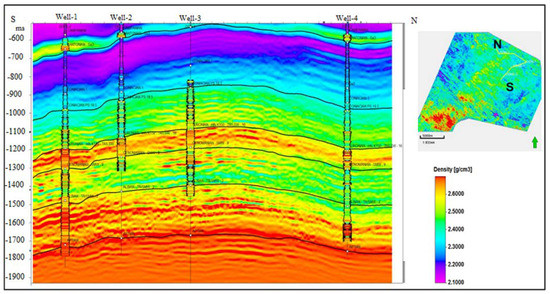
Figure 1.
Seismic trace crossing the four wells from the inverted density cube of the southeastern Algerian petroleum field. The lithologies from top to bottom are: Maastrichtian, Campanian, Santonian, Coniacian, Turonian, Cenomanian, Albian, and Aptian.
3. 1D Geomechanical Model Construction
To construct a 1D geomechanical model, the following parameters were experimentally determined: the static Young’s modulus, the static Poisson coefficient, the unconfined compressive strength (UCS), the resistance of the rock to the tension (TSTR), the friction angle, the pore pressure, and the vertical and horizontal constraints (minimum and maximum). Young’s modulus is a mechanical property that quantifies the proportion between tensile stress σ and axial strain ε in the linear elastic region of a rock, extracted directly from the velocity of the P-wave (Vp) and the S-wave (Vs) in the seismic data [18]. The UCS is the maximum axial compressive stress that a cylindrical sample of rock can withstand under unconfined laboratory conditions. The UCS relationship and the static Poisson ratio are obtained from laboratory test results. We took into consideration the local mechanical properties of the rock formation in the reservoir under study (Turonian) [19]. Based on the laboratory test results, the following values were obtained: static Young’s modulus = 0.8 × the dynamic Young’s modulus, static Poisson coefficient = dynamic Poisson factor, and TSTR = 6~8% of UCS [20]. Further, the total horizontal stresses were calculated using 1D poro-elastic theory. Since the rocks of this field have linear elastic and isotropic horizontal stresses, the calculation involved the Young’s modulus E, the Poisson ratio ν, the Biot constant α, the vertical litho-static stress σ𝑣, and the minimum and maximum strains εℎ and ε𝐻 [3,15]. These different measurements allowed the determination of a certain window density for the mud used during drilling in order to minimize the following damage:
- Kicks: the kicks are represented by the pore pressure shown in grey in the track of Figure 2 [21]. When greater than the pressure generated by the mud density, there will be a collapse of the wellbore [4];
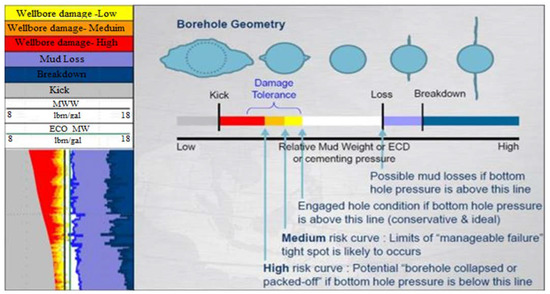 Figure 2. Typical flowchart of adequate mud density identification.
Figure 2. Typical flowchart of adequate mud density identification. - Shear failure: the shear failure is presented in red in the left track of Figure 2. It provides formation-breaking pressure due to the maximum in situ stress [21,22];
- Breakdown: the breakdown is presented in dark blue in the left track of Figure 2. A break in traction occurs when the mud density is greater than the maximum horizontal stress [21].
The results of the 1D geomechanical modelling for well 1 and well 2 are presented in Figure 3a,b, respectively. These are examples of the results obtained from the four wells.

Figure 3.
One-dimensional (1D) geomechanical model and mud density analysis for: (a) well 1, (b) well 2. The description of the curves from left to right is as follows: track 1—MD: measured depth (m), track 2—stratigraphy: limits of the geological formations, track 3—Young’s static modulus (GPa) curve in violet; Poisson ratio curve in light green; UCS (MPa) curve in red; TSTR (MPa) curve in yellow; and friction angle (Deg) curve in dark blue, track 4—interstitial pressure (Psi) curve in dark blue; vertical stress (Psi) curve in black; horizontal constraints (Smax in red, Smin in light green, Psi), track 5—the windows of wellbore stability, including interstitial pressure in grey, shear failure of the wellbore in yellow, fracture gradient in light blue and breakdown in dark blue [23].
The different phases of well 1 and well 2 are oval along the Marly intervals, mainly in the Campanian and Santonian formations, where severe types of damage were observed. These intervals were characterized by a very low UCS and, thus, they required a higher mud weight to stabilize the wellbore during drilling. The total drilling mud losses reported in the Maastrichtian formation are related to the presence of natural fractures that are not open to the fracture gradient ([24,25]). The Turonian and Coniacian formations, mainly in well 2, seemed to be more stable compared to the whole formation. We reduced the drilling mud weight in the Turonian formation to 1.05 sg in order to limit mud losses in the reservoir intervals. To confirm these conclusions and use them for the next planned wells, it was necessary to obtain reliable results. Therefore, we constructed a 3D geomechanical model based on seismic inversion. The model was then compared to 1D models for validation and generalization, as detailed in Section 4.
4. Three-Dimensional (3D) Geomechanical Model Construction
4.1. Generation of Vp and Vs Volumes
The relation between the Vp and the acoustic impedance (AI) was extracted by using the cross plot from logging data from the four wells [26]. It can be seen from Figure 4 that the relationship is linear, and it is expressed by Equation (1):
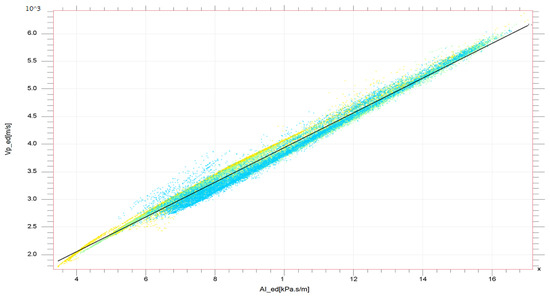
Figure 4.
Crossplot of Vp vs. AI, with Vp (m/s), AI (kPa.s/m), and the correlation of R = 0.78.
As the acoustic impedance volume was obtained from the seismic inversion results, a simple calculation was used to deduce the volume of the acoustic velocities, as shown in Figure 5a. Since the volumes of the ratio Vp/Vs and of Vp were calculated, the volume of Vs could, therefore, be directly deduced, as demonstrated in Figure 5b [16].
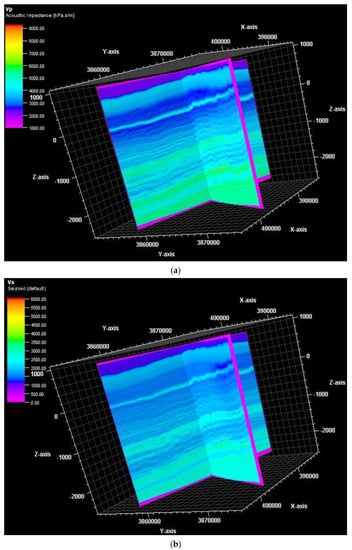
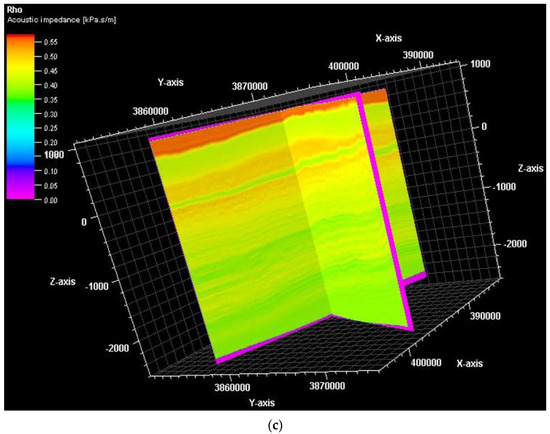
Figure 5.
Volumes generated using seismic inversion: (a) acoustic velocities (m/s), (b) shear rates, (c) density AI (k.Pa.s/m).
4.2. Density Volume Generation
Using the acoustic impedance and the acoustic velocity volumes, the density volume was extracted by using the relationship , as shown in Figure 5c. A comparison between the obtained inverted density model and the density logs from well 1 and well 2 is shown in Figure 6. The latter shows density values from inverted volumes (coloured) compared to logging data (black curves). Based on Figure 6, it can be concluded that the inverted model had high correlations at well 1 and well 2 in the studied field, as well as good correlations at well 3 and well 4. Therefore, we were able to proceed to 3D geomechanical model construction. The workflow of this process is summarized in Figure 7 ([6,27,28,29,30]).
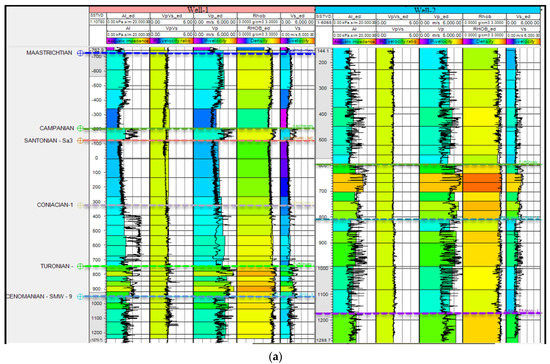
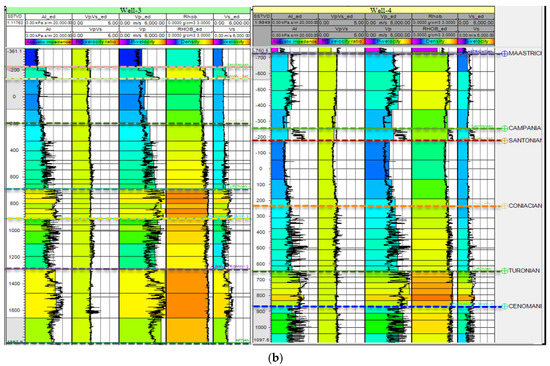
Figure 6.
Comparison of results from calculated volumes (coloured) and actual data (in black) for: (a) wells 1 and 2, (b) wells 3 and 4. The logs for each well are, from left to right, as follows: AI (kPa.s/m), Vp/Vs (no units), Vp (m/s), Rhob (g/cm3), and Vs (m/s).
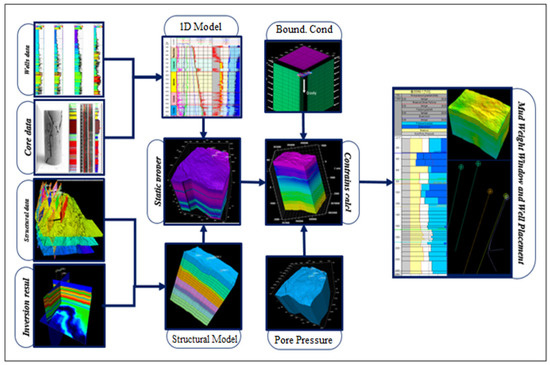
Figure 7.
Workflow of the 3D geomechanical model construction.
4.3. Digital Grid Creation
When building a 3D geomechanical model, the first step is to create the grid in which the computation of the constraints will be carried out [31]. The grid is guided by the geological model of the region and must contain the overlying layers in addition to the reservoir’s layers ([6,32]).
The geological model of the studied field consisted of 8 horizons, from the Maastrichtian to the Aptian. Forty-nine (49) faults, provided from the structural interpretation of the seismic data, were also included in the constructed model. Thus, from the geological point of view, a simple rectangular grid covering all horizons was created; containing 37 layers. Particular attention was given to the reservoir layers and the cover layer, increasing the resolution gradually to provide more details [33,34]. At the end of this step, the obtained grid was composed of 1,583,550 cells, as shown in Figure 8. It was used for reservoir characterization and rock typing [35].
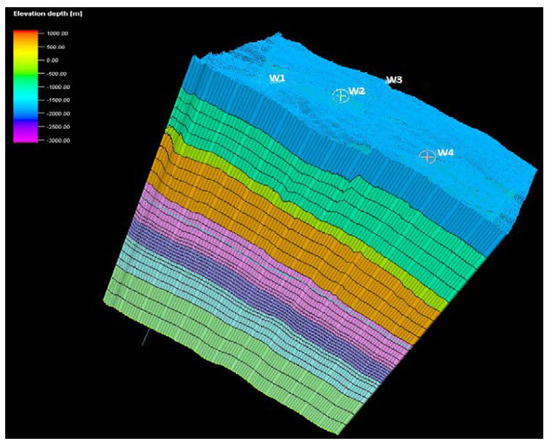
Figure 8.
Generated grids for the studied field.
4.4. Rock Typing
Once the grids were created, they were filled with the mechanical properties that characterized the rock; namely, the density, the elastic properties (Young’s modulus, Poisson ratio, and Biot coefficient), and the resistance properties (UCS, the resistance of the rock to tension, and the friction angle) [10]. These properties were calculated using the same method as in the 1D model constructed earlier in this study and with the same mathematical relationships [17]. The inputs of the model were the density volumes, Vp and Vs, and the dynamic elastic properties, which were determined directly from the inputs through the Gassmann equations (Equations (2)–(5)) [36,37].
where is the saturation gain function, is the bulk modulus of the rock, is the bulk modulus of the fluid, and is the Poisson ratio. These properties are called “dynamic” because of their high-frequency contents. Nevertheless, their calibration can be guaranteed using laboratory tests on cores: the UCS cube was calculated from a UCS vs. Young’s modulus correlation based on the regional core tests in the four wells, and the TSTR was estimated at 6–8% of the UCS [28]. The obtained 3D rock properties are illustrated in Figure 9.
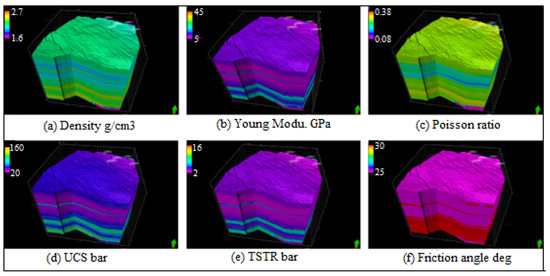
Figure 9.
Rock properties calculated from seismic inversion results: (a) density (g/cm3), (b) Young’s modulus (GPa), (c) Poisson ratio, (d) UCS (bar), (e) resistance to tension (bar), (f) friction region (deg).
It can be noted from Figure 10 that the properties calculated from the 3D cubes, which resulted from the inversion, remained faithful to the 1D models at wells 1, 2, and 3 [38]. Some inaccuracies were observed at the level of well 4 since the inputs (Vp, Vs, and Rhob cubes) were generated from logging data, which presented some unreliability problems for density logs at this well due to the presence of washout and doglegs (bad quality of the borehole).
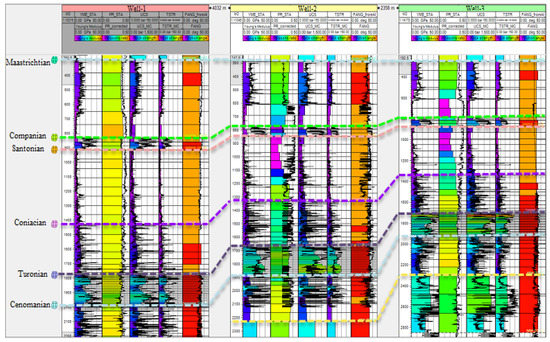
Figure 10.
Comparison between rock properties calculated from inversion (coloured) and log profiles (in black) for wells 1, 2, and 3. Logs for each well are, from left to right, as follows: Young’s modulus of elasticity YME (GPa), static Poisson ratio, UCS (bar), TSTR (bar), and friction region (degree).
4.5. Calculation of Limiting Conditions and Constraints
The constructed 3D geomechanical model allowed for the inclusion of all structural and mechanical information. In the constraint computation phase, a simulation was carried out using the finite element technique [39]. The outputs of the simulation were extracted and used for reservoir analyses and the design of new wells [40]. The simulation was undertaken in three steps. In the first step, the gravitational load was estimated over the entire volume to generate a cube of vertical stresses, which included faults and different mechanical properties. In step two, the boundary conditions were used to initialize the state of the constraints, and the pore pressure was also estimated. It should be noted that the state of stress at this step represented the initial conditions [18]. In step three, the constraints and pore pressure were iteratively calculated until they correlated with data at a predefined error threshold [17]. The different constraints that affected the model were calculated as follows:
- The vertical stress was determined from the density volume, and it was not quite accurate due to the quality of the seismic data. Nevertheless, the estimated vertical stresses remained close to the real values obtained from core data;
- The horizontal stresses, caused by the effects of tectonics, were estimated from the results of the 1D geomechanical model, which was established at the level of the four wells [30].
Effectively, the regional constraints were adjusted iteratively until they corresponded to the profiles of the different wells. In this study, seven simulations were required to find the best correlation between the estimated parameters and the data. The simulations were aimed at modelling the distribution of the stresses in the reservoir by taking into account the structures resulting from the seismic data interpretation ([21,40]). The values obtained from the simulation were the minimum horizontal deformation , the maximum horizontal deformation , and the azimuth equal to 45°, as shown in Figure 11. The results, shown in Figure 12, demonstrated a good correlation between the 3D and the 1D models. Since the 1D model could not include structural effects, the comparison was significant only for wells that were not located near to faults or structural features that could induce major stress rotations ([18,40]).
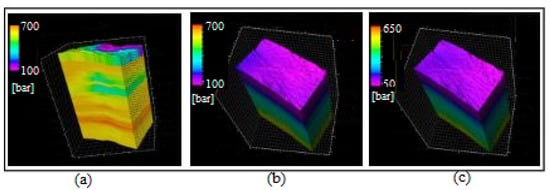
Figure 11.
Simulation results: (a) vertical stresses (bar), (b) maximum horizontal stress (bar), (c) minimum horizontal stress (bar).
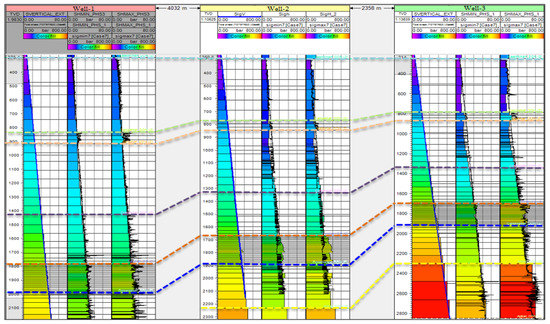
Figure 12.
Comparison of the results of the 3D model (coloured blocks) and the results of the 1D model. The tracks of each well are, from left to right, as follows: vertical stresses (bar), maximum horizontal stress (bar), minimum horizontal stress (bar).
5. Well Design
Determination of the Mud Density Window
As soon as the position of the new well (well 5) was defined, the 3D geomechanical model was used to analyse the wellbore stability and determine its ideal direction, in addition to establishing the optimal mud density window to minimize reservoir damage ([6,17,41]). The analysis included several trajectories, but only the alternative trajectories were selected for well 5. The proposed approach involved the creation of a mud density cube for each cell in the model and the definition of a limit of rupture (shear failure gradient), a limit of mud loss related to an induced fracture (fracture gradient), and a rupture limit for breakdown [42]. The size of the mud density window depended on the difference between the limits of these different gradients [32]. The stability of the wellbore depended on the relative orientation of the main stresses and the trajectory of the well. Thus, the creation of a single mud density cube required few assumptions about the orientation of the well. Typically, an initial cube is created assuming a vertical well (zero inclination), and then alternate cubes are created with tilts and azimuths, which represent the general intended directions of the wells [21]. Based on these assumptions, three mud density cubes were generated: a cube for the vertical well (0° inclination and 0° azimuth), a cube for the horizontal well simulated in the direction of the minimum horizontal stress (90° inclination and 45° azimuth), and a cube for the horizontal well simulated in the direction of the maximum horizontal stress (90° inclination and 135° azimuth).
The time slices shown in Figure 13, Figure 14 and Figure 15 represent the targeted reservoir (the Turonian) obtained from the three generated cubes, respectively. The simulation results show that the horizontal trajectories of the wells were slightly more stable than the vertical trajectories in the Turonian layer. There was a small difference in the mud density window between drilling in the direction of the minimum and maximum horizontal stresses. However, drilling in the direction of the minimum horizontal stress seemed better. As it is subject to uncertainties in the properties of the faults, it is strongly recommended to keep the wellbore at least 200 m far from the faults if possible. The stresses in these areas are unpredictable and the optimal mud density windows that guarantee wellbore stability will be very narrow.
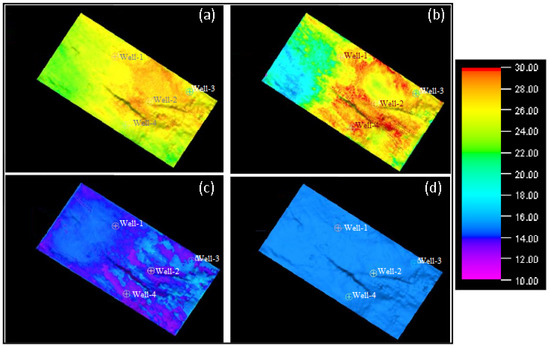
Figure 13.
First mud density cubes with 0° inclination and 0° azimuth in lbm/gal for vertical well: (a) fracture gradient, (b) breakdown, (c) breakout, (d) kick.
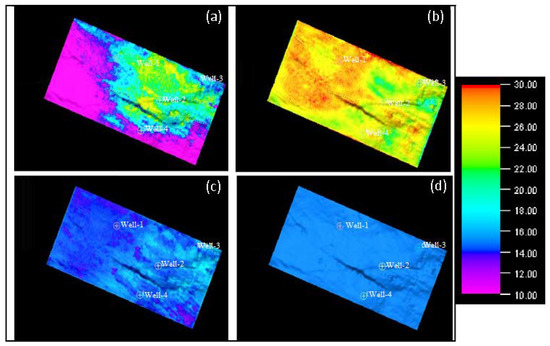
Figure 14.
Second mud density cube with 90° inclination and 45° azimuth in lbm/gal for vertical well: (a) fracture gradient, (b) breakdown, (c) breakout, (d) kick.
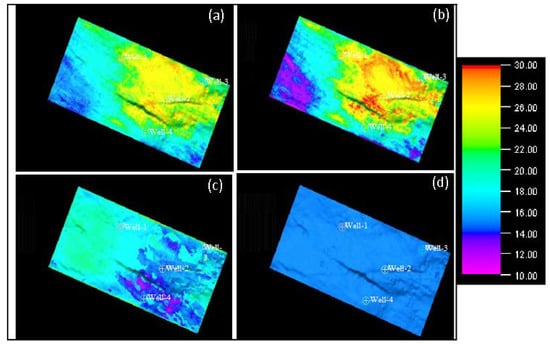
Figure 15.
Third mud density cube with 90° inclination and 135° azimuth in lbm/gal for horizontal well in maximum stress direction: (a) fracture gradient, (b) breakdown, (c) breakout, (d) kick.
A comparison between the mud weight windows (MWWs) for well 5 and the other four wells in the studied field is shown in Figure 16. The MWW was more favourable in well 5 than in the other wells. In the Turonian formation, the main challenge was to keep the rupture limit lower than the interstitial pressure at certain intervals. However, this could reduce the drilling mud weight in this section to its limit, and it could even lead to mud loss in the naturally fractured subintervals ([25,39]). The main limitation of this study is that the reliability and precision of the 3D geomechanical model obtained were strongly related to the vertical resolution of the seismic data. Furthermore, in order to ensure better results, it would be necessary to ensure good acquisition and design of the seismic field, which is not always available in southeastern Algeria due to its mountainous characteristics.

Figure 16.
Mud weight windows for the four wells compared to that of well 5.
6. Discussion
The 3D geomechanical model constructed provided us with the tools to estimate the optimal mud density window to be used to drill the planned well (well 5). This mud window could guarantee the stability of the wellbore of well 5, and there was no risk of reservoir invasion or fracturing in the Turonian formation. The mud window results are shown in Figure 16, and the curves can be interpreted as follows:
- Gary block: the pore pressure values. If they become higher than the pressure created by the mud density, a kick could occur in the Turonian formation at well 5. The kicks correspond to lower shelling of the walls that that applied by the geological formations around the well
- Yellow block: the fracture limit (shear failure or breakout). This occurs when the mud density is below the maximum in situ stress, but it should be controllable while drilling well 5 [42];
- Light blue block: the fracture gradient limit, which is caused by the minimum horizontal in situ stress. When the mud density is higher than the latter, this will open the existing fractures. This should also be controlled during the drilling of well 5 in order to avoid fracturing the Turonian formation;
- Dark blue block: the breakdown (tensile break). This occurs when the mud density is greater than the maximum horizontal stress. The latter should also be considered when drilling well 5.
In Figure 16, the drilling mud density window is represented by the white block located in the middle of the tracks. Hence, to avoid the various fractures previously mentioned for well 5, mud densities were estimated for each interval based on the results of the 3D geomechanical model [43]. For the interval 0–600 m MD (Maastrichtian), the obtained mud weight was MW = 1.05 g/cm3 (WBM); for the interval 600–1200 m MD (Maastrichtian–Campanian–Santonian), MW = 1.23 g/cm3 (OBM); for the interval 1200–1681 m MD (Coniacian), MW = 1.05 g/m3 (OBM); and for the interval 1681–2000 m MD (Turonian–Cenomanian), the obtained mud weight was MW = 1.05 g/cm3 (OBM). These mud density values can ensure wellbore stability with minimum damage to the targeted reservoir, as confirmed during the process of drilling well 5 and its reservoir evaluation.
7. Conclusions
- In this paper, a 3D geomechanical model was constructed in order to help drillers ensure the stability of the wellbores of hydrocarbon wells without damaging the reservoir in a petroleum field located in the southeast of Algeria;
- The seismic inversion cubes were used as the input data for the construction of the 3D geomechanical model. The 1D geomechanical profiles, generated at the wells’ scales, were used as basic tools for the construction of the 3D geomechanical model;
- The 3D geomechanical model provided information on the spatial distribution of the existing stresses in the reservoir and all subjacent layers;
- As a result, this study provides a powerful and reliable tool for drilling new wells and to optimize profitability by avoiding drilling incidents. It allows the estimation of the different mechanical properties of rocks at the seismic scale;
- This is an effective way to determine the mud density to be used when drilling new wells in a studied area, thus allowing the determination of the preferred direction for their boreholes;
- Furthermore, by obtaining such information, simulations of on-going wells can be performed at any position in the volume, and in any direction, so that an estimate of the drilling mud density window can be obtained simultaneously;
- In addition, this model can help drillers choose the location and the optimal direction of new wells with the maximum possible wellbore stability;
- The 3D geomechanical model can be also used to guide hydraulic fracturing supervisors in undertaking fracturing jobs in tight reservoirs based on the robust information on the spatial distribution of stresses, their directions, and their amplitudes.
Author Contributions
Conceptualization, M.Z.D. and S.D.; methodology, M.Z.D. and S.E.; software, T.K.L. and S.E.; validation, S.E., M.Z.D. and M.D.; formal analysis, K.F.T.; investigation, M.Z.D. and S.D.; resources, S.E. and M.D.; data curation, T.K.L. and S.E.; writing—original draft preparation, M.Z.D. and S.E.; writing—review and editing, K.F.T. and S.D.; visualization, M.D. and M.Z.D.; supervision, M.Z.D., S.D. and K.F.T.; project administration, S.E.; funding acquisition, S.D. All authors have read and agreed to the published version of the manuscript.
Funding
This research received no external funding.
Data Availability Statement
Not applicable.
Conflicts of Interest
The authors declare no conflict of interest.
References
- Ashraf, U.; Zhu, P.; Yasin, Q.; Anees, A.; Imraz, M.; Mangi, H.N.; Shakeel, S. Classification of reservoir facies using well log and 3D seismic attributes for prospect evaluation and field development: A case study of Sawan gas field, Pakistan. J. Pet. Sci. Eng. 2019, 175, 338–351. [Google Scholar] [CrossRef]
- Anees, A.; Zhang, H.; Ashraf, U.; Wang, R.; Liu, K.; Abbas, A.; Ullah, Z.; Zhang, X.; Duan, L.; Liu, F.; et al. Sedimentary Facies Controls for Reservoir Quality Prediction of Lower Shihezi Member-1 of the Hangjinqi Area, Ordos Basin. Minerals 2022, 12, 126. [Google Scholar] [CrossRef]
- Anees, A.; Zhang, H.; Ashraf, U.; Wang, R.; Liu, K.; Mangi, H.N.; Jiang, R.; Zhang, X.; Liu, Q.; Tan, S.; et al. Identification of Favorable Zones of Gas Accumulation via Fault Distribution and Sedimentary Facies: Insights from Hangjinqi Area, Northern Ordos Basin. Front. Earth Sci. 2022, 9, 822670. [Google Scholar] [CrossRef]
- McLean, M.; Addis, M. Wellbore Stability: The Effect of Strength Criteria on Mud Weight Recommendations. In Proceedings of the SPE Annual Technical Conference and Exhibition, New Orleans, Louisiana, 23–26 September 1990. [Google Scholar] [CrossRef]
- Eladj, S.; Lounissi, T.K.; Doghmane, M.Z.; Djeddi, M. Lithological Characterization by Simultaneous Seismic Inversion in Algerian South Eastern Field. Eng. Technol. Appl. Sci. Res. 2020, 10, 5251–5258. [Google Scholar] [CrossRef]
- Qiuguo, L.; Zhang, X.; Al-Ghammari, K.S.; Mohsin, L.; Jiroudi, F.; Al Rawahi, A. 3-D Geomechanical Modeling and Wellbore Stability Analysis in Abu Butabul Field. In Proceedings of the International Petroleum Conference and Exhibition (SPE), Abu Dhabi, United Arab Emirates, 11–14 November 2012. [Google Scholar] [CrossRef]
- Ashraf, U.; Zhang, H.; Anees, A.; Ali, M.; Zhang, X.; Abbasi, S.S.; Mangi, H.N. Controls on Reservoir Heterogeneity of a Shallow-Marine Reservoir in Sawan Gas Field, SE Pakistan: Implications for Reservoir Quality Prediction Using Acoustic Impedance Inversion. Water 2020, 12, 2972. [Google Scholar] [CrossRef]
- Wang, Y.; Ge, Q.; Lu, W.; Yan, X. Well-Logging Constrained Seismic Inversion Based on Closed-Loop Convolutional Neural Network. IEEE Trans. Geosci. Remote Sens. 2020, 58, 5564–5574. [Google Scholar] [CrossRef]
- Fohrmann, M.; Pecher, I. Analysing sand-dominated channel systems for potential gas-hydrate-reservoirs using an AVO seismic inversion technique on the Southern Hikurangi Margin, New Zealand. Mar. Pet. Geol. 2012, 38, 19–34. [Google Scholar] [CrossRef]
- Thanh, H.V.; Lee, K.-K. 3D geo-cellular modeling for Oligocene reservoirs: A marginal field in offshore Vietnam. J. Pet. Explor. Prod. Technol. 2021, 12, 1–19. [Google Scholar] [CrossRef]
- Giroldi, L.; Wallick, B.; Rodriguez-Herrera, A.; Koutsabeloulis, N.; Lowden, D. Applications of broadband seismic inversion in the assessment of drilling and completion strategies: A case study from eastern Saudi Arabia. SEG Tech. Program Expand. Abstr. 2014, 2014, 3153–3156. [Google Scholar] [CrossRef]
- Thanh, H.V.; Sugai, Y.; Sasaki, K. Impact of a new geological modelling method on the enhancement of the CO2 storage assessment of E sequence of Nam Vang field, offshore Vietnam. Energy Sources Part A Recover. Util. Environ. Eff. 2020, 42, 1499–1512. [Google Scholar] [CrossRef]
- Hale, A.H.; Mody, F.K.; Salisbury, D.P. The Influence of Chemical Potential on Wellbore Stability. SPE Drill. Complet. 1993, 8, 207–216. [Google Scholar] [CrossRef]
- Thanh, H.V.; Sugai, Y.; Nguele, R.; Sasaki, K. Integrated workflow in 3D geological model construction for evaluation of CO2 storage capacity of a fractured basement reservoir in Cuu Long Basin, Vietnam. Int. J. Greenh. Gas Control 2019, 90, 102826. [Google Scholar] [CrossRef]
- Thanh, H.V.; Sugai, Y. Integrated modelling framework for enhancement history matching in fluvial channel sandstone reservoirs. Upstream Oil Gas Technol. 2021, 6, 100027. [Google Scholar] [CrossRef]
- Yanghua, W. Seismic Inversion: Theory and Applications; Wiley Blackwell, John Whiler & Sons: Hoboken, NJ, USA, 2007; ISBN 9781119258025. [Google Scholar]
- Eladj, S.; Lounissi, T.K.; Doghmane, M.Z.; Djeddi, M. Wellbore Stability Analysis Based on 3D Geo-Mechanical Model of an Algerian Southeastern Field. In Advances in Geophysics, Tectonics and Petroleum Geosciences. CAJG 2019. Advances in Science, Technology & Innovation; Springer: Berlin/Heidelberg, Germany, 2022. [Google Scholar] [CrossRef]
- Boualam, A.; Rasouli, V.; Dalkhaa, C.; Djezzar, S. Stress-Dependent Permeability and Porosity in Three Forks Carbonate Reservoir, Williston Basin. In Proceedings of the Paper 54th U.S. Rock Mechanics/Geomechanics Symposium, Physical Event Cancelled, Golden, CO, USA, 28 June–1 July 2020. [Google Scholar]
- Bacetti, A.; Doghmane, M. A Practical Workflow Using Seismic Attributes to Enhance Sub Seismic Geological Structures and Natural Fractures Correlation. In Proceedings of the First EAGE Digitalization Conference and Exhibition, Vienna, Austria, 30 November–3 December 2020; Volume 2020, pp. 1–5. [Google Scholar] [CrossRef]
- Doghmane, M.Z.; Ouadfeul, S.A.; Benaissa, Z.; Eladj, S. Classification of Ordovician Tight Reservoir Facies in Algeria by Using Neuro-Fuzzy Algorithm. In Artificial Intelligence and Heuristics for Smart Energy Efficiency in Smart Cities. IC-AIRES 2021. Lecture Notes in Networks and Systems; Hatti, M., Ed.; Springer: Berlin/Heidelberg, Germany, 2021; Volume 361. [Google Scholar] [CrossRef]
- Gray, D.; Anderson, P.; Logel, J.; Delbecq, F.; Schmidt, D.; Schmid, R. Estimation of stress and geomechanical properties using 3D seismic data. First Break 2012, 30, 59–68. [Google Scholar] [CrossRef]
- Riaz, M.S.; Bin, S.; Naeem, S.; Kai, W.; Xie, Z.; Gilani SM, M.; Ashraf, U. Over 100 years of faults interaction, stress accumulation, and creeping implications, on Chaman Fault System, Pakistan. Int. J. Earth Sci. 2019, 108, 1351–1359. [Google Scholar] [CrossRef]
- Djezzar, S.; Rasouli, V.; Boualam, A.; Rabiei, M. An integrated workflow for multiscale fracture analysis in reservoir analog. Arab. J. Geosci. 2020, 13, 161. [Google Scholar] [CrossRef]
- Neves, F.A.; Al-Marzoug, A.; Kim, J.J.; Nebrija, E.L. Fracture characterization of deep tight gas sands using azimuthal velocity and AVO seismic data in Saudi Arabia. Lead. Edge 2003, 22, 469–475. [Google Scholar] [CrossRef]
- Boualam, A.; Djezzar, S.; Rasouli, V.; Rabiei, M. 3D Modeling and Natural Fractures Characterization in Hassi Guettar Field, Algeria. In Proceedings of the 53rd U.S. Rock Mechanics/Geomechanics Symposium, New York, NY, USA, 23–26 June 2019. [Google Scholar]
- Duffaut, K.; Landrø, M. Vp/Vs ratio versus differential stress and rock consolidation—A comparison between rock models and time-lapse AVO data. Geophysics 2007, 72, C81–C94. [Google Scholar] [CrossRef]
- Xiao, X.; Jenakumo, T.; Ash, C.; Bui, H.; Fakunle, O.; Weaver, S. An Integrated Workflow Combining Seismic Inversion and 3D Geomechanics Modeling—Bonga Field, Offshore Nigeria. In Proceedings of the Offshore Technology Conference, Houston, TX, USA, 2–5 May 2016. [Google Scholar] [CrossRef]
- Sengupta, M.; Dai, J.; Volterrani, S.; Dutta, N.; Rao, N.S.; Al-Qadeeri, B.; Kidambi, V.K. Building a seismic-driven 3D geomechanical model in a deep carbonate reservoir. In Proceedings of the SEG Technical Program Expanded Abstracts 2011, San Antonio, TX, USA, 18–23 September 2011; pp. 2069–2073. [Google Scholar] [CrossRef]
- Trudeng, T.; Garcia-Teijeiro, X.; Rodriguez-Herrera, A.; Khazanehdari, J. Using Stochastic Seismic Inversion as Input for 3D Geomechanical Models. In Proceedings of the IPTC 2014: International Petroleum Technology Conference, Doha, Qatar, 10–12 December 2014; Volume 2014, pp. 1–6, EAGE. [Google Scholar] [CrossRef]
- Ranjbar, A.; Hassani, H.; Shahriar, K. 3D geomechanical modeling and estimating the compaction and subsidence of Fahlian reservoir formation (X-field in SW of Iran). Arab. J. Geosci. 2017, 10, 116. [Google Scholar] [CrossRef]
- Eladj, S.; Doghmane, M.Z.; Aliouane, L.; Ouadfeul, S.-A. Porosity Model Construction Based on ANN and Seismic Inversion: A Case Study of Saharan Field (Algeria). In Advances in Geophysics, Tectonics and Petroleum Geosciences. CAJG 2019. Advances in Science, Technology & Innovation; Springer: Berlin/Heidelberg, Germany, 2022. [Google Scholar] [CrossRef]
- Convers, C. Prediction of Reservoir Properties for Geomechanical Analysis Using 3-D Seismic Data and Rock Physics Modeling in the Vaca Muerta Formation, Neuquén Basin, Argentina. Ph.D. Thesis, Colorado School of Mines, Golden, CO, USA, 2017. [Google Scholar]
- Ashraf, U.; Zhang, H.; Anees, A.; Mangi, H.N.; Ali, M.; Zhang, X.; Imraz, M.; Abbasi, S.S.; Abbas, A.; Ullah, Z.; et al. A Core Logging, Machine Learning and Geostatistical Modeling Interactive Approach for Subsurface Imaging of Lenticular Geobodies in a Clastic Depositional System, SE Pakistan. Nonrenewable Resour. 2021, 30, 2807–2830. [Google Scholar] [CrossRef]
- Alalimi, A.; AlRassas, A.M.; Thanh, H.V.; Al-Qaness, M.A.A.; Pan, L.; Ashraf, U.; Al-Alimi, D.; Moharam, S. Developing the efficiency-modeling framework to explore the potential of CO2 storage capacity of S3 reservoir, Tahe oilfield, China. Géoméch. Geophys. Geo-Energy Geo-Resour. 2022, 8, 128. [Google Scholar] [CrossRef]
- Cherana, A.; Aliouane, L.; Doghmane, M.; Ouadfeul, S.-A. Fuzzy Clustering Algorithm for Lithofacies Classification of Ordovician Unconventional Tight Sand Reservoir from Well-Logs Data (Algerian Sahara). In Advances in Geophysics, Tectonics and Petroleum Geosciences. CAJG 2019. Advances in Science, Technology & Innovation; Springer: Berlin/Heidelberg, Germany, 2022. [Google Scholar] [CrossRef]
- Berryman, J.G. Origin of Gassmann’s equations. Geophysics 1999, 64, 1627–1629. [Google Scholar] [CrossRef]
- Goodway, B.; Perez, M.; Varsek, J.; Abaco, C. Seismic petrophysics and isotropic-anisotropic AVO methods for unconventional gas exploration. Lead. Edge 2010, 29, 1500–1508. [Google Scholar] [CrossRef]
- Doghmane, M.Z.; Belahcene, B.; Kidouche, M. Application of Improved Artificial Neural Network Algorithm in Hydrocarbons’ Reservoir Evaluation. In Renewable Energy for Smart and Sustainable Cities. Lecture Notes in Networks and Systems 62; Hatti, M., Ed.; Springer: Berlin/Heidelberg, Germany, 2018; pp. 129–138. [Google Scholar] [CrossRef]
- Correa, A.C.F.; Newman, R.B.; Naveira, V.P.; de Souza, A.L.S.; Araujo, T.; da Silva, A.A.C.; Soares, A.C.; Herwanger, J.V.; Meurer, G.B. Integrated Modeling for 3D Geomechanics and Coupled Simulation of Fractured Carbonate Reservoir. In Proceedings of the Offshore Technology Conference, OTC Brasil, Rio de Janeiro, Brazil, 29–31 October 2013. [Google Scholar] [CrossRef]
- Po, C.; Lee, E.-J. Full-3D Seismic Waveform Inversion: Theory, Software and Practice, Springer Geophysics; Springer International Publishing: Berlin/Heidelberg, Germany, 2015; ISBN 978-3-319-16603-2. [Google Scholar] [CrossRef]
- Cheatham, J.J., Jr. Wellbore Stability. J. Pet. Technol. 1984, 36, 889–896. [Google Scholar] [CrossRef]
- Djezzar, S.; Rasouli, V.; Boualam, A.; Rabiei, M. Size Scaling and Spatial Clustering of Natural Fracture Networks Using Fractal Analysis. In Proceedings of the 53rd U.S. Rock Mechanics/Geomechanics Symposium, New York, NY, USA, 23–26 June 2019. [Google Scholar]
- Eladj, S.; Doghmane, M.Z.; Belahcene, B. Design of New Model for Water Saturation Based on Neural Network for Low-Resistivity Phenomenon (Algeria). In Advances in Geophysics, Tectonics and Petroleum Geosciences. CAJG 2019. Advances in Science, Technology & Innovation; Springer: Berlin/Heidelberg, Germany, 2022. [Google Scholar] [CrossRef]
Publisher’s Note: MDPI stays neutral with regard to jurisdictional claims in published maps and institutional affiliations. |
© 2022 by the authors. Licensee MDPI, Basel, Switzerland. This article is an open access article distributed under the terms and conditions of the Creative Commons Attribution (CC BY) license (https://creativecommons.org/licenses/by/4.0/).